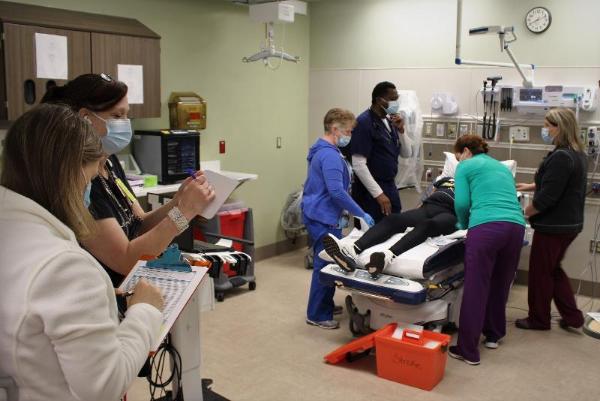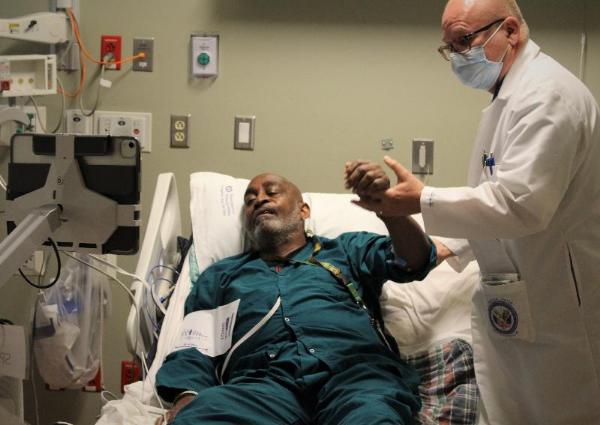Virtual Simulation Helps Grow Telestroke During COVID Operations
By: David J. Adriansen, Ed.D, NREMT, CHSE, NTSP Director of Simulation | VA National Telestroke Program, Office of Connected Care, Palo Alto VA Health Care System
Jane A. Anderson, Ph.D., RN, FNP-C, FAANP, NTSP Chief Nursing Officer and Chief of Implementation Services | VA National Telestroke Program, Office of Connected Care, Palo Alto VA Health Care System
The VA National Telestroke Program (NTSP) serves Veterans with acute stroke symptoms at VA emergency departments, urgent care centers, and hospitals. Each year, the VHA reports approximately 4,500 Veterans are diagnosed with an acute ischemic stroke (AIS). According to the American Stroke Association, stroke is the 5th leading cause of death in the United States and a leading cause of serious long-term disability. Dr. Glenn Graham, Telestroke Program Executive Champion, and original founder in 2017, explained the program has grown in providing acute stroke expertise to VA facilities that lack around-the-clock acute stroke coverage. The NTSP is comprised of a virtual “hub” of VA stroke neurologists located around the country that participate in a 24/7/365 call schedule to provide coverage to participating facilities.
When a Veteran with acute stroke symptoms presents at a participating VA facility, front-line staff use a mobile device to videoconference with the Telestroke Neurologist. The neurologist examines the patient, reviews the medical record and CT images, advises the local treating physician as to a diagnosis and recommended treatment, and documents recommendations in the patient record. These recommendations are executed by the local treating provider.
Once official travel was minimized in March 2020 due to the pandemic, the NTSP Implementation Team had to transition to virtual training. After four months of adapting curriculum and processes, the NTSP was able to conduct its first Go-Live Course in August 2020 at the Albuquerque VA via livestreaming coaching and educational presentations. A new four-day virtual Go-Live Activation Course culminated in separate Emergency Department and ICU Telestroke Simulations. VA laptops and a livestreaming meeting application were used so both hospital and NTSP staff could observe remotely. Each simulation was followed by a structured debriefing and Process Flow Mapping discussion.
Dr. Jane Anderson, NTSP Chief Nursing Officer and Director of Implementation Services, explained “prior to COVID-19, NTSP Team members would travel to a VA Telestroke Facility to conduct a 2.5 Day Go-Live Course, including 2-3 Telestroke Simulations.” The team uses standardized patients in simulation scenarios involving a patient presenting with stroke symptoms. The mock stroke code is completed in all areas of the facility involved in the care of an acute stroke patient. Mobile technology and simulated waveforms on actual patient monitors are used to increase simulation fidelity. The patient is followed through initial diagnosis, communications with the Telestroke Neurologist, CT Scan and medication administration.
Dr. Anderson reported “since Albuquerque, 9 VA Facilities have since been trained virtually, with an additional 6 to be completed in FY2021.” While COVID-19 impacted in-person training, the request for and ability to activate Telestroke services grew. The use of novel technology and techniques helped support educational curriculum and facilitate Telestroke simulation scenarios used to identify and drive process improvements for acute stroke care.
On May 6, 2021, the Leavenworth VA completed Virtual Go-Live Activation Training, including both ED and ICU scenarios. Kristi Masterson, RN, Simulation Coordinator, felt the virtual simulations, “exhibited Eastern Kansas Healthcare System staff have been given the tools and training presented by the VA National Telestroke team to feel confident to Go-Live with patients. The virtual simulations were a true reflection of how hard work, dedication and persistence pays off in the end and gives us hope for our future in healthcare.”
According to David Adriansen, NTSP Director of Simulation, the field of VA Telemedicine continues to expand and is positively impacting care for our Veterans. The Telestroke Program is forecasted to activate services at 20 VA Medical Centers annually through FY2025. Telestroke uses Virtual Reality, Serious Gaming, Artificial Intelligence and Standardized Patients to help reinforce provider learning and improve patient care. Please contact the NTSP Team at info@ntsp.us for questions on the VA Telestroke Program.
Telestroke Simulation during GoLive in the Leavenworth VA ED. Simulated stroke patient being assessed by ED Physician and RNs as RN Process Flow Captain and Timekeeper observes. (L-R) Lisa Hansen, RN, Kristi Masterson, RN, Lorie Mace, RD, Dr Girma Assefa, Lillian Goodman, RN and Kelly Armontrout, RN. VA Staff Photograph by Joseph Roe.
ICU MD conducted stroke assessment as guided by Telestroke Neurologist at Leavenworth VA. (L-R) William Burton, Standardized Patient and James Hignight, MD. VA Staff Photograph by Joseph Roe.





















